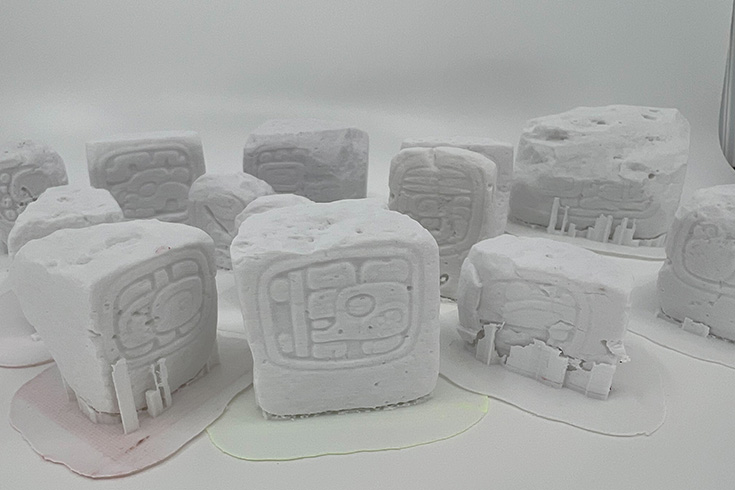3D Printing Mayan History with the Glyph Block Project
Feb. 18, 2022
 Brandeis MakerLab Maker in Residence Clara Alexander discusses her work on the Glyph Block Project.
Brandeis MakerLab Maker in Residence Clara Alexander discusses her work on the Glyph Block Project.
The Glyph Block Project is based on archaeological materials recovered from the ancient Maya site of El Resbalón in southern Quintana Roo, Mexico. In the 1970s, a hieroglyphic stairway consisting of 220 engraved stone blocks was discovered and after being photographed, the blocks were moved to a nearby office. The blocks vary in their size and shape, but on average they are around 30x30x25 centimeters, with a median weight of about 80 pounds. In the summer of 2021, myself, my colleague Cynthia Hannold, and our PI Alexandre Tokovinine traveled to Quintana Roo, Mexico to create 3D scans of each block. Now, with the help of the Brandeis library and MakerLab, I seek to 3D print miniature versions of the blocks at 15% of their original size.
Creating this miniature set has multiple important benefits for the study of the blocks. First of all, for reasons still unknown, the original order of the blocks was scrambled at some point before the site’s discovery. Unlike most hieroglyphic stairways in the Maya area, whose hieroglyphs are placed in a logical narrative order and tell a story when read, the placement of Resbalón’s blocks appears to be random. Furthermore, some Resbalón blocks contain partial glyphs that ostensibly were carved to overlap onto neighboring blocks, further suggesting that the stairway discovered in the 1970s was indeed a modified version of an earlier original stairway.
Hieroglyphic stairways, like many ancient Maya monuments, tend to contain historical information about a site’s leaders and geopolitical conflicts, and reading them has been foundational to our knowledge of Maya civilization. For these reasons, deciphering the story of Resbalón’s stairway is of critical importance. The task of putting these blocks back in order, by matching up partial glyphs, comparing shape and size of the blocks, and studying their narrative content, is extremely cumbersome if one is using the actual stones, which as previously mentioned are heavy and large in addition to being delicate archaeological materials. Not to mention, the blocks are in Mexico, making them much harder to access. Therefore, creating miniature replicas of the blocks will dramatically ease the task of restoring their original order, and will spare us having to travel back to Mexico and risk damaging the delicate remains of ancient Maya life.